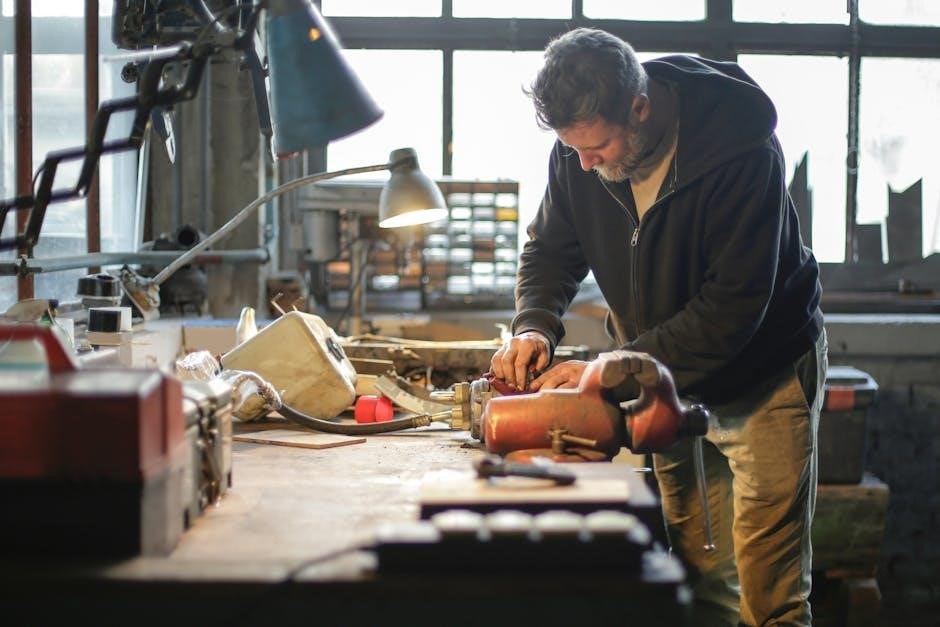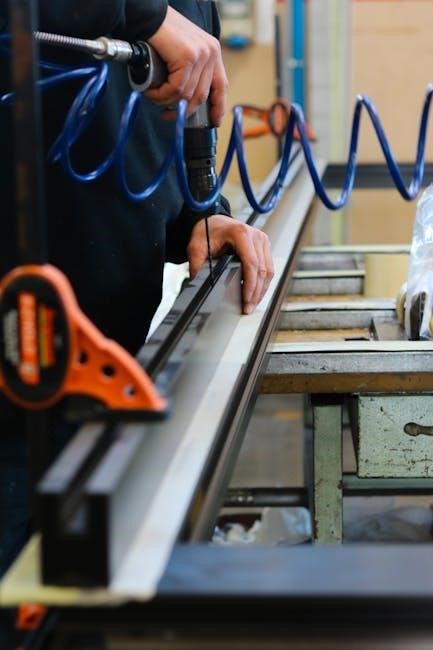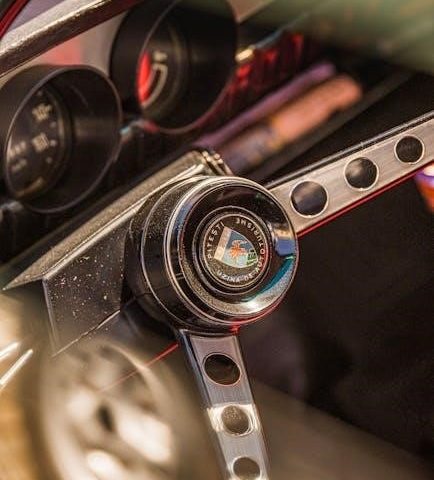A manual shifter assembly is a crucial component in vehicles, enabling drivers to control gear shifts. Its mechanical complexity ensures smooth transitions between gears, balancing performance and efficiency.

Components of Manual Shifter Assembly
The manual shifter assembly consists of the shift lever, shift fork, gears, and synchronizers. These components work together to enable smooth gear transitions and precise control over the transmission system.
Shift Lever
The shift lever is the primary interface between the driver and the manual transmission. Located centrally in the cabin, it allows the driver to manually select gears. The lever connects to the transmission via a linkage system, translating the driver’s movements into gear changes. Its design includes a spring-loaded mechanism to return to the neutral position after each shift, ensuring smooth operation. Modern shift levers often feature ergonomic designs for comfort and precision. The lever’s movement is guided by a shift gate, preventing accidental gear selections. Proper alignment and adjustment of the shift lever are critical for accurate gear engagement, making it essential for both performance and driver experience. Regular maintenance ensures optimal functionality and longevity of the shift lever assembly.
Shift Fork
The shift fork is a critical component within the manual transmission, responsible for engaging and disengaging gears. It operates by moving the gear selector collar to align with the desired gear. Connected to the shift lever via linkages, the fork translates the driver’s input into precise mechanical movements. Its design ensures smooth gear transitions by synchronizing the speed of rotating components. The shift fork’s alignment and spacing are crucial for proper engagement, preventing misalignment that could cause damage or difficulty in shifting. Typically constructed from durable materials like hardened steel, the fork withstands the repeated stress of gear changes. Regular maintenance, such as lubrication and alignment checks, is essential to maintain optimal performance and prevent wear. The shift fork’s role is vital in enabling drivers to control the transmission efficiently and effectively.
Gears
In a manual shifter assembly, gears are toothed wheels that transmit power between the engine and the wheels. They are designed to vary the speed and torque of the vehicle. Each gear ratio corresponds to a specific speed range, allowing the engine to operate efficiently. The gears are typically mounted on parallel shafts, with the input shaft connected to the engine and the output shaft to the drivetrain. Synchronizers ensure smooth engagement by aligning the speed of the gear with the shaft. The gears are engaged by the shift fork, which moves the selector collar to lock the desired gear in place. Proper lubrication is essential to reduce friction and wear. Over time, gears can wear out, leading to issues like grinding or difficulty shifting. Regular maintenance, such as checking gear oil levels and inspecting for wear, helps prolong the life of the gears and ensures smooth operation.

How Manual Shifter Assembly Works
The manual shifter assembly operates by transmitting the driver’s gear selection through a shift lever, synchronizers, and gears. This mechanism enables smooth engagement of desired ratios for optimal vehicle performance.
Driver Input
Driver input is essential for the operation of a manual shifter assembly. The process begins with the driver depressing the clutch pedal, disconnecting the engine from the transmission. This allows the driver to move the shift lever into the desired gear position. The shift lever is connected to a series of linkages and forks inside the transmission, which engage specific gears based on the driver’s selection. The clutch pedal must be pressed fully to ensure smooth gear changes. The driver must also use the accelerator pedal to control engine speed during shifting, preventing jerky movements. Proper coordination between the clutch, accelerator, and gear lever is critical for efficient and smooth operation. Driver skill and experience play a significant role in mastering this process.
Gear Selection Process
The gear selection process in a manual shifter assembly involves a precise sequence of mechanical actions. When the driver moves the shift lever, it triggers the shift fork to engage the appropriate gear. The shift fork aligns with a collar, which locks the selected gear into place. This process ensures that only one gear is engaged at a time. The clutch pedal must be fully depressed to disconnect the engine from the transmission, allowing the gear change to occur smoothly. As the driver releases the clutch, the engine reconnects with the transmission, and the selected gear takes effect. The synchronizers play a key role in this process, ensuring that the gear engagement is seamless by matching the speed of the engine and transmission. The driver must coordinate the clutch, accelerator, and shift lever to achieve smooth and efficient gear transitions. This process requires practice and skill to master.
Role of Synchronizers
Synchronizers play a critical role in the smooth operation of a manual shifter assembly. These components are responsible for aligning the speed of the engine with the gear being selected. When the driver initiates a gear change, the synchronizer engages, ensuring that the gear teeth mesh properly without grinding. This process involves the synchronizer ring and cone, which create friction to synchronize the speeds of the moving parts. The synchronizer mechanism simplifies the gear selection process, making it easier for drivers to transition between gears. By reducing the complexity of manual shifting, synchronizers minimize wear and tear on the transmission components. They also help to reduce the physical effort required from the driver, especially during frequent gear changes. Properly functioning synchronizers ensure a smoother driving experience and extend the lifespan of the transmission system. Their role is essential for maintaining the efficiency and reliability of the manual shifter assembly.
Types of Manual Transmissions
Manual transmissions include front-wheel drive (FWD) setups, dual-clutch systems for rapid shifting, and traditional manual systems requiring clutch engagement. Each type offers distinct driving experiences and mechanical benefits.
Front-Wheel Drive (FWD) Transmissions
Front-wheel drive (FWD) manual transmissions are designed to deliver power solely to the front wheels. This configuration is common in smaller vehicles and city cars, offering better traction and reduced weight. The manual shifter assembly in FWD vehicles typically features a transverse-mounted gearbox, which simplifies the drivetrain layout. The shift lever connects to a set of forks that engage specific gears, allowing the driver to control acceleration and deceleration smoothly. The synchronizer plays a key role in aligning gears during shifts, ensuring minimal wear and tear. FWD transmissions are known for their fuel efficiency and compact design, making them ideal for urban driving conditions. They also require less complex engineering compared to rear-wheel drive systems, which translates to lower production costs. Overall, FWD manual transmissions strike a balance between performance, practicality, and affordability.
Dual-Clutch Transmissions
Dual-clutch transmissions (DCTs) represent a hybrid between manual and automatic systems, offering the efficiency of a manual transmission with the convenience of an automatic. These transmissions use two clutches to manage odd and even gears, allowing for faster and smoother shifts. The manual shifter assembly in DCTs is often electronic, with the computer controlling the clutches to pre-select gears. This eliminates the need for a clutch pedal, blending manual-like control with automatic functionality. DCTs are praised for their rapid shifting and improved fuel efficiency compared to traditional automatics. However, they can feel less engaging for drivers who prefer the tactile experience of a manual transmission. Despite this, dual-clutch systems are increasingly popular in modern vehicles, particularly in performance-oriented models, as they combine the benefits of both transmission types. Their integration with advanced driver-assistance systems further enhances their appeal in today’s automotive market.
Automatic vs. Manual Transmissions
The debate between automatic and manual transmissions centers on driving experience and practicality. Manual transmissions, with their clutch pedal and gear shifter, require active driver engagement, offering precise control and typically better fuel efficiency. Automatic transmissions, on the other hand, simplify driving by automatically shifting gears without driver input. They are more convenient in heavy traffic but often lag behind manuals in performance and efficiency. Manuals are favored by driving enthusiasts for their tactile feedback and sporty feel, while automatics appeal to those prioritizing ease and comfort. Both systems have evolved, with modern manuals incorporating electronic aids and automatics adopting advanced dual-clutch technologies. The choice between them ultimately depends on personal preference, driving conditions, and the desired balance between performance and convenience. This dichotomy continues to shape the automotive landscape, with each transmission type serving distinct purposes.

Electronic Integration in Modern Manual Shifters
Modern manual shifters now incorporate electronic systems, such as sensors and control modules, to enhance shifting precision and driver experience. These systems optimize gear transitions and reduce mechanical wear, blending tradition with innovation for improved performance.
Shift Gate Mechanism
The shift gate mechanism is a critical component in modern manual shifters, designed to guide the driver through gear selections. It operates by physically limiting the movement of the shift lever, ensuring that gears are engaged in the correct sequence. This mechanism typically consists of a gate that moves in synchronization with the driver’s input, blocking or allowing access to specific gears based on the current gear position. For example, when in first gear, the gate may prevent the lever from moving directly to reverse, reducing the risk of accidental gear selection. Additionally, the shift gate mechanism often incorporates detents or notches that provide tactile feedback, helping the driver feel when a gear is properly engaged. This system enhances safety and ease of use, making manual shifting more intuitive and preventing errors that could lead to mechanical damage. By integrating both mechanical and electronic controls, the shift gate mechanism ensures smooth and precise gear transitions, adapting to the demands of modern driving.
Control Module Functions
The control module in a manual shifter assembly plays a pivotal role in managing the electronic and mechanical interactions of the system. It acts as the brain, processing inputs from the driver, such as gear selection and clutch engagement, to ensure smooth and precise gear transitions. The module integrates with the vehicle’s broader systems, including the engine control unit and traction control, to optimize performance and safety. By monitoring parameters like engine speed, gear position, and driver input, the control module can prevent misshifts or premature wear on components. Modern control modules also incorporate advanced features like rev-matching and adaptive shift logic, enhancing the driving experience. Additionally, the module can communicate with other vehicle systems to provide real-time feedback, such as gear position indicators or alerts for potential issues. This integration of electronic control with mechanical functionality ensures that the manual shifter assembly operates efficiently and reliably in a wide range of driving conditions.

Advantages of Manual Shifter Assembly
Manual transmissions offer better fuel efficiency, increased driver control, and a more engaging driving experience. They are lighter, more reliable, and cost-effective compared to automatics.
Fuel Efficiency
Manual transmissions are known for their superior fuel efficiency compared to automatics. By allowing drivers to control gear shifts, they optimize engine speed and torque, reducing fuel consumption. This is especially true in stop-and-go traffic, where manual drivers can downshift to maintain lower engine RPMs, minimizing fuel waste. Additionally, manual transmissions typically have fewer mechanical components than automatics, leading to lighter overall weight and less energy loss through hydraulic systems. Studies show that manual transmissions can improve fuel economy by up to 5-10% in city driving conditions. This makes them a popular choice for eco-conscious drivers and those seeking cost savings on fuel. The direct connection between the driver and the vehicle enhances efficiency, ensuring power is used more effectively.
Disadvantages of Manual Shifter Assembly
Manual transmissions require driver skill and can be complex to operate smoothly. They demand constant engagement, making them less convenient in heavy traffic or for inexperienced drivers.
Complexity and Driver Skill Requirement
The manual shifter assembly involves intricate mechanical components that require precise driver input. Operating it demands coordination between the clutch pedal and shift lever, making it challenging for inexperienced drivers. The process of engaging gears smoothly necessitates practice and skill, as improper technique can lead to issues like gear grinding or difficulty shifting. This complexity is a significant disadvantage, especially in environments requiring frequent stops or in heavy traffic, where constant gear changes can be tiresome. Additionally, the mechanical linkages and synchronization processes add to the system’s sophistication, making it less accessible to those unfamiliar with manual transmissions. As a result, while many enthusiasts appreciate the control manual shifters offer, they are not ideal for all drivers due to the skill and concentration required.

Common Issues in Manual Shifter Assembly
Manual shifter assemblies can face several common issues that affect their performance and reliability. One frequent problem is wear and tear on components such as synchronizers, gear teeth, and shift forks, which can lead to difficulty in engaging gears smoothly. Grinding or hesitation during shifts often indicates worn synchronizers or misaligned gears. Another issue is fluid leaks from the transmission system, which can reduce hydraulic pressure and impair gear engagement. Additionally, the clutch pedal may fail to disengage properly, causing the gears to clash or the car to jerk during shifts. Misalignment of the shift lever or forks can also prevent gears from engaging or disengaging correctly. Over time, these issues can escalate if not addressed, leading to costly repairs. Regular maintenance and prompt attention to early warning signs are essential to extend the lifespan of the manual shifter assembly.

Maintenance Tips for Manual Shifter Assembly
Regular maintenance is essential to ensure the longevity and smooth operation of a manual shifter assembly. One key tip is to check and replace the transmission fluid periodically, as it lubricates the gears and synchronizers, preventing wear and tear. Inspecting the clutch pedal and adjusting its free play can also prevent premature wear on the clutch and gearbox. Additionally, monitoring the shift lever for proper alignment and tightness is crucial, as loose connections can lead to misalignment and gear engagement issues. Cleaning the shift linkage and applying grease to moving parts can reduce friction and ensure smooth shifts. Drivers should also avoid “riding the clutch,” as this can overheat and damage the clutch assembly. Regularly inspecting for leaks and addressing any unusual noises or vibrations promptly can prevent minor issues from escalating into major repairs. Consistent upkeep ensures optimal performance and reliability of the manual shifter assembly.


